Managing pain is essential for maintaining a good quality of life Physiotherapy Center, especially for those with chronic pain conditions. While medications are often effective, many people seek natural alternatives to avoid side effects or dependency. Thankfully, there are numerous natural ways to relieve pain that can complement or replace conventional treatments. This article will explore 11 effective ways to alleviate pain naturally, helping you regain comfort and control over your daily activities.
Exercise and Physical Activity
Regular exercise helps release endorphins, the body’s natural painkillers. Endorphins reduce pain perception and improve mood. Low-impact activities like walking, swimming, or yoga enhance flexibility and strengthen muscles, providing support to painful areas, especially in conditions like arthritis or back pain.
Start slowly and increase activity gradually to prevent overexertion.
Heat and Cold Therapy
Applying heat or cold to the affected area is a simple yet effective way to relieve pain. Cold therapy reduces inflammation and numbs sharp pain, while heat therapy relaxes muscles and improves blood circulation.
How to Use:
- Use ice packs for acute pain or swelling (10–15 minutes).
- Use heating pads or warm towels for chronic pain or muscle stiffness (15–20 minutes).
Massage Therapy
Massage therapy relaxes muscles, improves circulation, and reduces stress, all of which help alleviate pain. It’s especially beneficial for back pain, headaches, and muscle tension. Techniques like deep tissue massage or trigger point therapy can target specific areas of discomfort.
Regular massages can prevent pain from recurring and improve mobility.
Mindfulness Meditation and Deep Breathing
Mindfulness meditation teaches you to focus on the present moment, helping you manage pain by reducing stress and emotional tension. Deep breathing exercises also trigger the body’s relaxation response, lowering pain perception.
How to Practice:
- Sit comfortably and take slow, deep breaths.
- Focus on each inhale and exhale, letting go of stress.
- Practice for 10–15 minutes daily for long-term benefits.
Acupuncture
Acupuncture is an ancient Chinese therapy that involves inserting thin needles into specific points on the body. It is thought to stimulate nerve function and release natural pain-relieving chemicals like endorphins. Acupuncture has been shown to be effective for chronic pain, including back pain, migraines, and arthritis.
Ensure you visit a certified acupuncturist for safe treatment.
Herbal Remedies and Supplements
Several herbs and supplements have anti-inflammatory and pain-relieving properties. Some of the most commonly used include:
- Turmeric: Contains curcumin, which reduces inflammation.
- Ginger: Helps with muscle pain and joint stiffness.
- Boswellia: Known for reducing arthritis pain.
- Magnesium: Eases muscle cramps and tension.
Always consult your doctor before starting new supplements.
Epsom Salt Baths
Epsom salts contain magnesium, which can be absorbed through the skin to relax muscles and reduce pain. Warm Epsom salt baths are especially helpful for muscle soreness, joint pain, and stress relief.
How to Use:
- Add 2 cups of Epsom salt to a warm bath.
- Soak for 15–20 minutes.
- Repeat 2–3 times a week for the best results.
Essential Oils and Aromatherapy
Certain essential oils have anti-inflammatory and soothing properties. Aromatherapy uses these oils to promote relaxation and pain relief. Popular oils include:
- Lavender: Relieves headaches and muscle tension.
- Peppermint: Helps with migraines and joint pain.
- Eucalyptus: Reduces inflammation and eases respiratory discomfort.
How to Use:
- Add a few drops of essential oil to a diffuser.
- Mix with a carrier oil and apply topically for targeted relief.
Chiropractic Care
Chiropractic adjustments align the spine and relieve pressure on nerves, which can reduce pain in the back, neck, and joints. It’s particularly effective for those with chronic back pain or tension headaches.
Regular chiropractic care can improve posture and prevent recurring pain.
Diet and Hydration
What you eat plays a significant role in managing pain. An anti-inflammatory diet can reduce pain and swelling in chronic conditions like arthritis. Focus on:
- Fruits and vegetables (rich in antioxidants)
- Omega-3 fatty acids (found in fish and flaxseeds)
- Whole grains and healthy fats
Hydration is equally important, as dehydration can worsen muscle cramps and headaches. Aim for 8–10 glasses of water per day to support muscle function and joint lubrication.
Sleep and Rest
Adequate sleep is essential for the body’s natural healing processes. Lack of sleep can worsen pain and fatigue, creating a cycle of discomfort. Develop good sleep hygiene by:
- Going to bed and waking up at the same time daily.
- Creating a relaxing bedtime routine.
- Limiting screen time before bed.
If pain interferes with sleep, try using supportive pillows or practicing relaxation techniques before bedtime.
Conclusion
Managing pain naturally involves a holistic approach, combining physical activity, relaxation techniques, dietary changes, and complementary therapies. Whether you’re dealing with chronic pain or occasional discomfort, these 11 natural remedies can help you find relief and improve your overall well-being.
While these methods can be highly effective, it’s important to consult with a healthcare provider if your pain persists or worsens. With consistency and the right combination of natural strategies, you can take control of your pain and enjoy a healthier, more comfortable life


